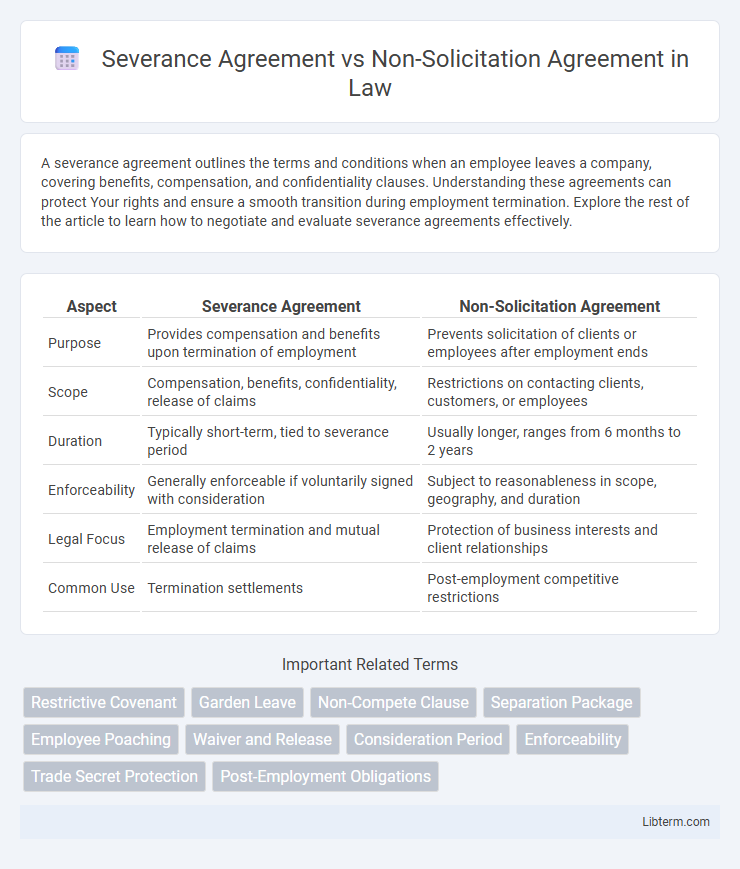A severance agreement outlines the terms and conditions when an employee leaves a company, covering benefits, compensation, and confidentiality clauses. Understanding these agreements can protect Your rights and ensure a smooth transition during employment termination. Explore the rest of the article to learn how to negotiate and evaluate severance agreements effectively.
Table of Comparison
| Aspect | Severance Agreement | Non-Solicitation Agreement |
|---|---|---|
| Purpose | Provides compensation and benefits upon termination of employment | Prevents solicitation of clients or employees after employment ends |
| Scope | Compensation, benefits, confidentiality, release of claims | Restrictions on contacting clients, customers, or employees |
| Duration | Typically short-term, tied to severance period | Usually longer, ranges from 6 months to 2 years |
| Enforceability | Generally enforceable if voluntarily signed with consideration | Subject to reasonableness in scope, geography, and duration |
| Legal Focus | Employment termination and mutual release of claims | Protection of business interests and client relationships |
| Common Use | Termination settlements | Post-employment competitive restrictions |
Understanding Severance Agreements
Severance agreements outline the terms under which an employee leaves a company, often including compensation, benefits, and confidentiality clauses to protect both parties. These agreements differ from non-solicitation agreements, which specifically restrict former employees from contacting or recruiting the company's clients or staff for a set period. Understanding severance agreements helps ensure fair treatment during employment termination and clarifies the obligations and rights of both employer and employee.
Key Elements of Non-Solicitation Agreements
Non-solicitation agreements primarily protect businesses by prohibiting former employees from soliciting clients, customers, or employees for a specified period after leaving the company. Key elements include the scope of restricted parties, duration of the restriction, and the geographic area covered to prevent unfair competition. These agreements must be reasonable in scope and duration to be enforceable and clearly define prohibited solicitation activities to ensure legal compliance and business protection.
Purpose and Scope: Severance vs Non-Solicitation
A Severance Agreement primarily addresses the terms of employee separation, including compensation, benefits, and mutual release of claims, aiming to protect both parties during the transition. In contrast, a Non-Solicitation Agreement restricts a former employee or contractor from soliciting the company's clients, employees, or vendors to prevent competitive harm. The scope of severance agreements centers on departure conditions and post-employment obligations, while non-solicitation agreements focus explicitly on preserving business relationships and competitive advantage.
Legal Implications of Severance Agreements
Severance agreements legally define the terms of employee departure, including compensation, confidentiality, and release of claims, protecting employers from future litigation. They often require employees to waive rights to sue for wrongful termination, discrimination, or other employment-related disputes. Properly drafted severance agreements ensure compliance with labor laws such as the Fair Labor Standards Act (FLSA) and the Older Workers Benefit Protection Act (OWBPA), mitigating legal risks for organizations.
Legal Enforceability of Non-Solicitation Clauses
Non-solicitation clauses within severance agreements often face intense scrutiny regarding their legal enforceability, varying significantly across jurisdictions based on reasonableness in scope, duration, and geographic reach. Courts typically uphold these clauses only if they protect legitimate business interests such as trade secrets or customer relationships without imposing undue hardship on the departing employee. The enforceability of non-solicitation agreements hinges on clear, narrowly tailored language and compliance with state-specific laws, especially those that limit post-employment restrictions.
Employee Rights and Restrictions
A Severance Agreement primarily outlines the employee's rights to compensation and benefits after termination, often including clauses on confidentiality and release of claims, whereas a Non-Solicitation Agreement restricts employees from soliciting clients or coworkers post-employment. Employee rights under a Severance Agreement typically include severance pay, continuation of healthcare benefits, and waiver of legal claims, while Non-Solicitation Agreements impose specific limitations aimed at protecting business interests without offering direct financial benefits. Understanding these distinctions is crucial for employees negotiating terms to safeguard both their post-employment rights and avoid undue restrictions on future employment opportunities.
Employer Considerations in Drafting Agreements
Employers drafting severance agreements must clearly outline terms regarding compensation, confidentiality, and release of claims to mitigate future disputes and protect company interests. Non-solicitation agreements require precise language defining the scope, duration, and geographic limits to prevent former employees from poaching clients or staff while remaining enforceable. Careful alignment with state laws and consideration of employee roles enhances the effectiveness and legality of both agreements.
Common Pitfalls and Legal Challenges
Severance agreements often face common pitfalls such as vague language regarding compensation and unclear conditions for release of claims, leading to enforceability issues. Non-solicitation agreements encounter legal challenges related to overly broad restrictions that may be deemed unreasonable under state laws, risking invalidation or limitation by courts. Both agreements require precise drafting to balance protection of business interests with compliance to enforceability standards and employee rights.
State Laws Impacting Enforcement
State laws significantly influence the enforcement of severance agreements and non-solicitation agreements, with variations affecting their validity and scope. For instance, California largely prohibits non-solicitation agreements, deeming them unenforceable under Business and Professions Code Section 16600, while severance agreements are generally upheld if they comply with statutory requirements regarding consideration and disclosure. In contrast, states like New York enforce non-solicitation clauses more rigorously, provided they are reasonable in duration and geographic scope, and require that severance agreements meet disclosure and fairness standards under labor laws.
Best Practices for Negotiating Agreements
Effective negotiation of severance agreements and non-solicitation agreements requires clear understanding of key terms such as compensation, duration, and scope of restrictions to ensure mutual benefit and legal compliance. Parties should prioritize transparency about post-employment obligations and tailor non-solicitation clauses to protect legitimate business interests without imposing overly broad limitations. Engaging legal counsel to review draft agreements helps balance enforceability with fairness, minimizing disputes and preserving professional relationships.
Severance Agreement Infographic

 libterm.com
libterm.com